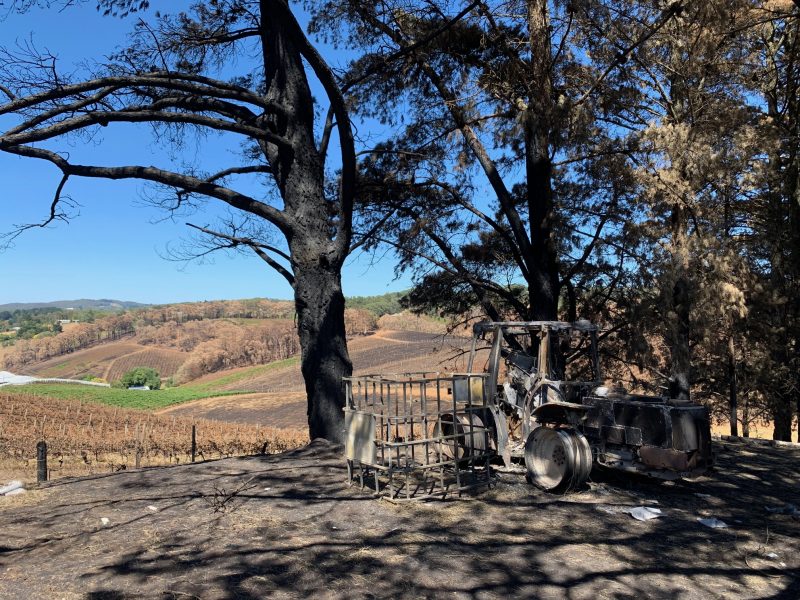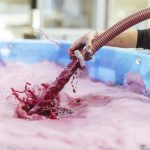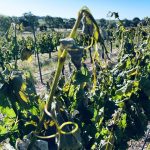Further details are emerging about the impact the bushfires have tolled on grape and wine producers in some of Australia’s affected wine regions.
Authorities are currently evacuating residents of the town of Parndana, on South Australia’s Kangaroo Island, as the severity of bushfire conditions worsen there.
There is no indication, at this stage, of any direct fire-related threat to the island’s vineyards and wineries.
Victoria
In Victoria, Wine Victoria is working closely with the Country Fire Authority (CFA) and regional wine associations across the state to monitor and assess the situation.
In addition, to properly understand the impacts on producers, Wine Victoria have compiled a survey for producers to complete.
This firsthand information will provide producers with a broad picture of how widespread the damage is to date, whether that be assets damaged, vineyard damage, and/or the presence of smoke in a particular area.
Australian Grape & WIne (AGW) is encouraging all Victorian producers to complete this survey, as it will inform their discussions with government and federal agencies and AGW, to ascertain the support that may be required for Victorian producers as they move into recovery mode.
Emergency Relief Assistance Payments are available for up to seven days after the event if you are unable to access or live in your home because of an emergency.
Emergency Re-establishment assistance is available if your principal place of residence (your home) is uninhabitable for more than seven days because of an emergency.
The Victorian State Government has also established a new agency, Bushfire Recovery Victoria (BRV) which will be wholly focused on the needs of Victorian communities, working closely with locals to ensure that rehabilitation projects are both locally-driven and locally-delivered.
Hunter Valley
Meanwhile, in New South Wales, in terms of the effects on the Hunter Valley wine region and 2020 vintage it is still too early to tell the scale of the damage.
Smoke taint is a reasonably new and inexact body of science and the region is currently working through all the options and procedures at their disposal to evaluate any perceived risk.
The Hunter Valley is a very large valley and there are many factors at play, including proximity to the fire, elevation, and days in smoke contact.
Reports suggest that for most of the Hunter Valley, the fires haven’t been too close to vineyards.
The region is working closely with the Australian Wine Research Institute (AWRI) and last Friday sent 110 samples from across the region to be tested for all of the free and bound compounds that could be a present in finished wine.
Many vignerons have begun their harvest, guided by results from these smoke tests from the AWRI and sensory evaluation of micro ferments.
AGW says The Hunter Valley is Australia’s oldest and most resilient region at nearly 200 years old. They have had good years and bad years and whatever 2020 brings, they are a resilient region and remain positive and productive in the face of the challenges from drought and fire.
NSW Government Disaster Relief Grants are available for eligible individuals and families whose homes and essential household contents have been damaged or destroyed by a natural disaster.
Adelaide Hills
In South Australia, an alert was issued for residents in the Williamstown, Mount Crawford and Kersbrook areas where a fire sparked in the South Para Reservoir and burnt about four hectares.
The fire has been contained but the Country Fire Service (CFS) urges residents to stay alert and monitor local conditions.

To date, the fires have impacted more than 60 grapegrowers and wine producers and the flow-on effect within the region will be severe.
The devastation has hit close to home for growers, producers and wineries in the region with significant loses of vineyards, buildings, equipment, machinery and wine.
To help these local growers and producers and fund recovery efforts, the Adelaide Hills Wine Region set up a fire appeal, to ensure that all those affected, whether a grape grower, winemaker or brand, can fairly benefit from the goodwill of so many people and businesses who have already contributed with cash, wine and experience donations.
The money raised through donations, fundraisers and auctions will be used to directly support the 63 growers and producers in the fire area and secondly the local wine industry. None of the funds will go towards administration costs.
Producers are now able to access immediate Government Assistance. South Australian producers can apply for Recovery Grants for Bushfire Affected Communities in South Australia.
Eligible producers may access grants up to $15,000, which is being administered through PIRSA.
Rural Business Support is providing assistance to South Australian businesses to develop and implement plans to recover including with preparation for discussions with banks, lenders and insurance companies and in generating cash flow forecasts to meet financial obligations. They can be contacted by calling 1800 836 211.
Finlaysons Lawyers are hosting a Bushfire Insurance Session at 4pm at Goldings Wines on 13 February. Registrations and further information can be found at the Finlaysons Website.
Among the growing list of damaged and affected wineries is Henschke, which has been severely impacted by the recent Cudlee Creek bushfire in the Adelaide Hills.
The Grapegrower & Winemaker spoke with Henschke viticulturist, Prue Henschke, to determine the extent of the damage to their Lenswood vineyard.
Adelaide Hills wineries suffer catastrophic fire damage
In the wake of the bushfire, which is reported to have ignited from a fallen powerline just prior to Christmas 2019, the fire tore through Henschke’s Lenswood vineyard causing monumental damage.
The site was almost completely reduced to cinders and tore through the vineyard and its equipment, causing over $1.5 million in damages.
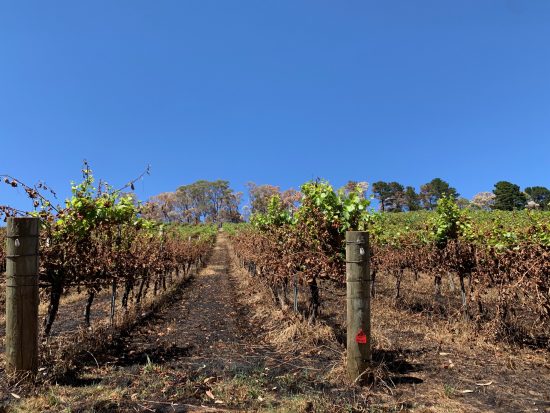
Prue Henschke said they will need long-term planning in order to fully rebuild in the aftermath of the fire.
“About 90 per cent of our Lenswood vineyard burnt down, it’s a huge impact for us and the region as it produces about 25% of the region’s grapes,” she said.
“We lost most of the vineyard in Lenswood, two sheds full of specialised vineyard equipment, trellis and irrigation systems and it totals about $1.6 million.”
Henschke continued that some of the vines burnt by the fire were some of the oldest Pinot Noir vines in the region, a huge blow to the region’s heritage wine reputation.
“Sadly the damage to the Lenswood site includes some of the oldest Pinot Noir in the Adelaide Hills, planted by Tim Knappstein in 1983,” she said.
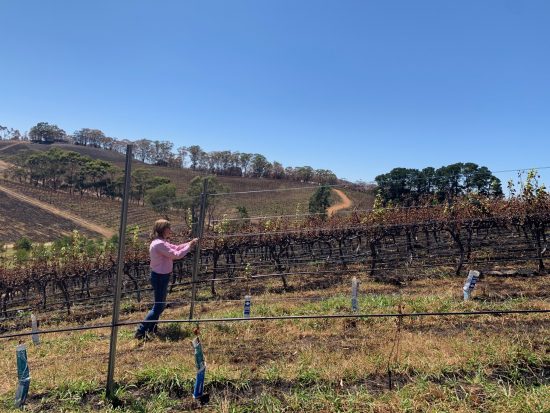
She continued that it’s not all doom and gloom, though, as hope for vineyard recovery lies in the knowledge of a grower and wine producer from a similar fire in 2015.
“Greg Horner, from Mount Bera Vineyards, has been invaluable for growers in the region because of his knowledge of vine recovery following his vineyard’s recovery after the Sampson Flat bushfire in 2015. He made a full and remarkable recovery,” she commented.
“Just looking at the vineyard, there’s a lot of hope for vine regrowth already. We’re seeing small shoots growing from the burnt trunks and crowns. Whether it will last we don’t know, but we do see our recovery taking about two years.”
Henschke went on to thank the efforts committed by fire crews of the Country Fire Service of South Australia and said their thoughts lie with all the affected growers in the region.
AGW update
Throughout this unprecedented bushfire crisis, Australian Grape & Wine says it has been in close contact with affected wine regions to gather updates on fire damage.
Meanwhile, AGW says it is seeking the reinstatement of the WET rebate for 2020 bulk wine purchased for blending with own grape wine, and bottled to packaged branded product given the potential of smoke damaged grapes.
The organisation is also seeking an extension of the pool for the Wine Tourism and Cellar Door Grant to be extended to $20 million per annum, more funds for state and regional tourism, and support for smoke testing.
AGW is working closely with the relevant government departments and agencies to expedite any potential arrangements.
Longer-term investment in R&D for vineyard management and in-winery remediation options to mitigate smoke taint, increased funding for regional tourism and financial support for growers are priority issues to ensure producers are supported throughout the recovery process.
All eligible Australian producers can apply for the Federal Government’s Disaster Recovery Payment (DRP).
This is a one-off payment of $1000 for eligible adults and $400 for eligible children who have been directly affected by a major disaster either in Australia or overseas. The DRP is not means tested.
For those who have lost their income as a direct result of the bushfires, the Government will provide a Disaster Recovery Allowance giving those eligible up to 13 weeks income support.
The Federal Government will establish a new agency with an initial $2 billion for a national bushfire recovery fund to coordinate a national response to rebuild communities and livelihoods after the devastating fire-front has passed.
The Insurance Council of Australia can be contacted with any questions, complaints or concerns about insurance on 1800 734 621. Consumer advocacy group Choice also has a comprehensive overview on Insurance for bushfire affected people and businesses.
AGW says that Australia is hurting from the fires, but remains open for business. It is calling for donations to relief funds, support for emergency services, consumers to buy affected winery’s produce and visit our regions. It says it is important to note that the fire season is not over and temporary relief may not last.

